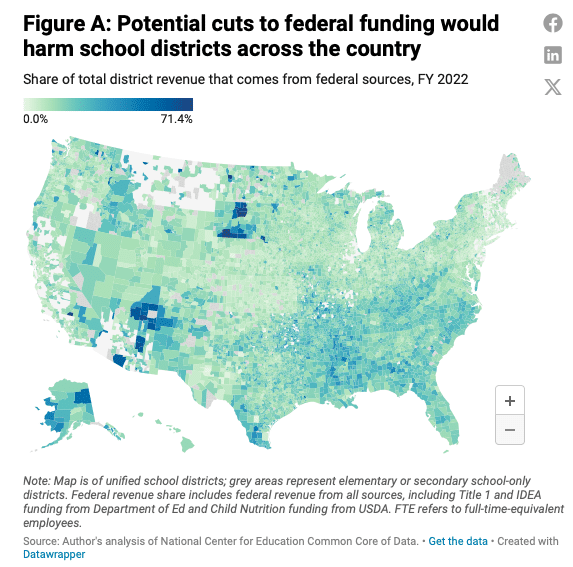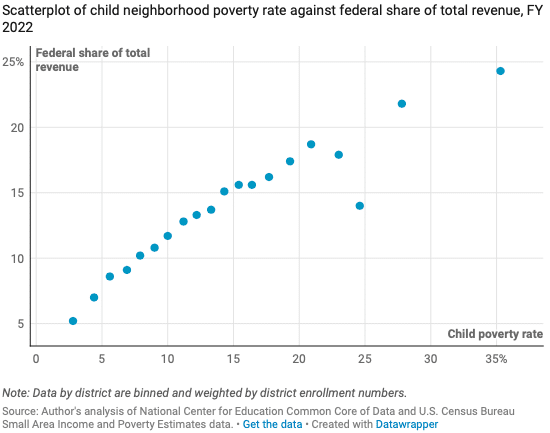Last month, President Trump ordered Secretary of Education Linda McMahon to move forward with plans to close the Department of Education (ED). While this move is illegal and has been met with litigation, it shows the Trump administration’s hostility to public education and raises deep concerns about how public school districts across the country will be able to properly fund schools in the face of potential steep federal cuts.
The Trump administration occasionally makes vague promises that it will maintain current federal resources flowing to public schools, but this is far from assuring. Today’s federal education aid is extremely well-targeted toward high-need districts, and even if the level of federal aid to states is maintained, it’s not clear that it would remain as well-targeted.
Currently, a large share of ED funding goes to high-poverty districts through Title I funds and to special education programs through IDEA programs. These resources are crucial in offsetting the differences in local funding between low- and high-income districts, which rely heavily on property taxes. Over the last few years, COVID relief packages bolstered federal funding to public schools, with the Elementary and Secondary Schools Emergency Relief fund helping districts recover from learning losses that occurred during the pandemic. In 2022, districts received 14.0% of their total revenue, on average, from federal sources.
To get a sense of how this federal money is distributed, we used data from the National Center for Education Statistics to calculate district-level estimates of federal revenue shares, the amount of Title I and IDEA funds each district receives, and the federal funding equivalent in the number of full-time teachers and staff. The results of this analysis can be seen in Figure A. Federal funding is crucial for schools across the country—the median amount a school district receives is $2.69 million. Federal funds make up less than 20% of a district’s budget in most cases (82%), but some districts rely on the federal government to contribute a much larger share of their funding—as much as 71.4% at the highest end.
Figure A also shows that because federal funds are meant to make up for state and local funding shortfalls, they are unevenly distributed across the country. Of the 25% of districts that receive the highest shares of revenue from the federal government, 54.6% are in the South. Removing this financial support would do disproportionate harm to children who live in a region that already severely underfunds public services. Additionally, states like Arizona and South Dakota would see massive cuts to their public schools, especially those that primarily serve Indigenous students. Nine of the 10 districts nationally with the highest revenue shares of federal funding are on or near reservations. These cuts would exacerbate racial inequity across the country.

Key to ED’s efficacy is that the revenue is redistributive: 51% goes to the third of schools with the highest neighborhood poverty while 18% goes to the third of districts with the lowest neighborhood poverty. Figure B shows a scatterplot of the share of federal revenue going to a district and the number of children with family income below the poverty line. The scatterplot is basically a straight line: As neighborhood poverty in a district increases, so too does the share of federal funding going to support that district. This basic need and special education funding serves children with high learning needs, ensures that there are enough support staff, and—coupled with child nutrition funding—helps students get proper nutrition in addition to receiving a quality education. Given the strong relationship between neighborhood poverty and federal funding, it’s hard to imagine a different program being more effective at reducing inequalities in education than the Department of Education’s spending priorities in K—12.

Figure B: Federal funding is largest in districts with highest levels of neighborhood poverty
Given the unprecedented nature of these administrative actions, many organizations have responded with useful fact sheets and data tools showing how dismantling the Department of Education would affect their states (see here, here, here, and here). These data tools all tell a consistent story regarding the significance of federal aid, but they tend to differ in some details. For example, our district-level estimates include all federal funding that supports education, including grants beyond the Department of Education, such as grants from the United States Department of Agriculture (USDA) that support child nutrition. We break down these overall estimates into separate categories for Title I funding and IDEA funding, which directly come from ED, so that users can see the role each program plays in overall funding. This choice means that our total federal funding estimates are larger than other estimates that strictly use ED grants from the FY2023—FY2025 president’s budget. Further, our district-level estimates, which are from FY 2021—2022, exclude charter schools and very small districts (districts with fewer than 100 students), whereas some other fact sheets and data tools don’t make this exclusion.
Finally, we use data from the National Center of Education Statistics, which are retrospective and rely on actual spending data reported to the Census Bureau. Other data sources on district school funding include the federal Department of Education’s budget service or state-level education departments. Often, these other sources will include more timely data but are based on grants that are allocated rather than already spent. While there are differences between what these various sources report about federal aid to districts for education, the differences tend to be quite small.
Overall, the Trump administration’s policy choices could have devastating consequences on children’s well-being and educational success . Further, these choices are in line with a broader Republican attack on public education, which often begin with criticisms about curriculum decisions (complaints about excess focus on diversity, equity, and inclusion measures and left-wing “indoctrination” are all too common.) But behind these culture war complaints lies a quieter, yet devastating, attack on the basic level of resources available to public schools to educate children. The larger Republican goal—pursued at both federal and state levels—seems clear: starve funding to K—12 schools.

